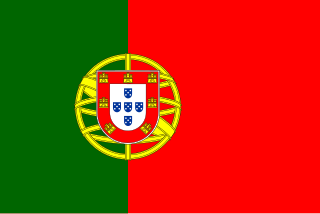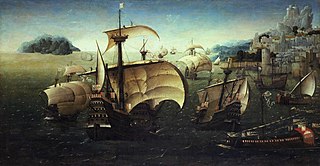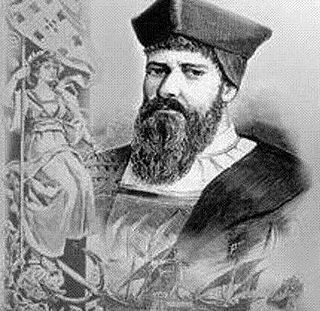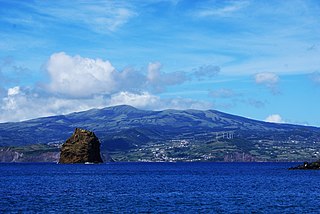
D. Vasco da Gama, 1st Count of Vidigueira, was a Portuguese explorer and nobleman who was the first European to reach India by sea.

The State of India, also known as the Portuguese State of India or Portuguese India, was a state of the Portuguese Empire founded six years after the discovery of the sea route to the Indian subcontinent by Vasco da Gama, a subject of the Kingdom of Portugal. The capital of Portuguese India served as the governing centre of a string of military forts and maritime ports scattered along the coasts of the Indian Ocean.

The Battle of Diu was a naval battle fought on 3 February 1509 in the Arabian Sea, in the port of Diu, India, between the Portuguese Empire and a joint fleet of the Sultan of Gujarat, the Mamlûk Burji Sultanate of Egypt and the Zamorin of Calicut.

A carrack is a three- or four-masted ocean-going sailing ship that was developed in the 14th to 15th centuries in Europe, most notably in Portugal and Spain. Evolving from the single-masted cog, the carrack was first used for European trade from the Mediterranean to the Baltic and quickly found use with the newly found wealth of the trade between Europe and Africa and then the trans-Atlantic trade with the Americas. In their most advanced forms, they were used by the Portuguese and Spaniards for trade between Europe, Africa and Asia starting in the late 15th century, before being gradually superseded in the late 16th and early 17th centuries by the galleon.

João da Nova was a Galician-born explorer in the service of Portugal. He is credited as the discoverer of Ascension and Saint Helena islands.
Dom Diogo Rodrigues, Dom Diogo Roiz was a Portuguese explorer of the Indian Ocean who sailed as an ordinary helmsman under the command of Dom Pedro Mascarenhas around Goa. They sailed from the Cape of Good Hope eastward into little-known waters of the newly discovered route to Goa. Rodrigues island was named after him between 4 and 9 February 1528 because he had discovered it during his only return journey from Goa via Cochin to Lisbon, where he was elevated to the rank of a knight (cavaleiro) by John III of Portugal. He then returned to Goa and made a mark in the history of the Portuguese empire in the subcontinent around the mid-16th century.

Jan Huygen van Linschoten was a Dutch spy, merchant, traveller and writer.

Santa Catarina was a Portuguese merchant ship, a 1500-ton carrack, that was seized by the Dutch East India Company on 25 February 1603 off Singapore. She was such a rich prize that her sale proceeds increased the capital of the VOC by more than 50%. From the large amounts of Ming Chinese porcelain captured in this ship, Chinese pottery became known in Holland as Kraakporselein, or "carrack-porcelain" for many years.

The Dutch–Portuguese War was a global armed conflict involving Dutch forces, in the form of the Dutch East India Company, the Dutch West India Company, and their allies, against the Iberian Union, and after 1640, the Portuguese Empire. Beginning in 1598, the conflict primarily involved the Dutch companies and fleet invading Portuguese colonies in the Americas, Africa, and the East Indies. The war can be thought of as an extension of the Eighty Years' War being fought in Europe at the time between Spain and the Netherlands, as Portugal was in a dynastic union with Spain after the War of the Portuguese Succession, for most of the conflict. However, the conflict had little to do with the war in Europe and served mainly as a way for the Dutch to gain an overseas empire and control trade at the cost of the Portuguese.
Sir Charles Ralph Boxer FBA GCIH was a British historian of Dutch and Portuguese maritime and colonial history, especially in relation to South Asia and the Far East. In Hong Kong he was the chief spy for the British army intelligence in the years leading up to World War II.

Madre de Deus was a Portuguese ocean-going carrack, renowned for her capacious cargo and provisions for long voyages. She was returning from her second voyage East under Captain Fernão de Mendonça Furtado when she was captured by the English during the Battle of Flores in 1592 during the Anglo–Spanish War. Her subsequent capture stoked the English appetite for trade with the Far East, then a Portuguese monopoly.

This article is a comprehensive list of all the actual possessions of the Portuguese Empire.

The Portuguese Indian Armadas were the fleets of ships funded by the Crown of Portugal, and dispatched on an annual basis from Portugal to India. The principal destination was Goa, and previously Cochin. These armadas undertook the Carreira da Índia from Portugal, following the maritime discovery of the Cape route, to the Indian subcontinent by Vasco da Gama in 1497–99.

The História trágico-marítima is a famous 18th-century collection of narrative accounts of the travails and wrecks of several Portuguese ships, principally carracks (naus) on the India run between 1552 and 1602, and the oft-harrowing stories of their survivors.
The Órfãs d'El-Rei were Portuguese girl orphans who were sent from Portugal to overseas colonies during the Portuguese Empire as part of Portugal's colonization efforts. The orphans were married to native rulers or Portuguese settlers.

The Battle of Flores (1592), also known as Cruising Voyage to the Azores of 1592, or the Capture of the Madre de Deus describes a series of naval engagements that took place from 20 May to 19 August 1592, during the Anglo-Spanish War. The battle was part of an expedition by an English fleet initially led by Sir Walter Raleigh, and then by Martin Frobisher and John Burgh. The expedition involved the capture of a number of Portuguese and Spanish ships including the large Portuguese carrack Madre de Deus, after a long naval battle off the island of Flores in the Azores. The expedition, particularly the capture of the great carrack, was a financial and military success. The rich cargo aboard the carrack, which at the time equaled nearly half the size of the Kingdom of England's royal annual revenue, was subject to mass theft when it arrived in Dartmouth, England, followed by quarrels over the shares of the prize. The expedition had formative consequences for the English both financially and on the future of English exploration.

The Action of Faial or the Battle of Faial Island was a naval engagement that took place on 22–23 June 1594 during the Anglo-Spanish War in which the large and richly laden 2,000-ton Portuguese carrack Cinco Chagas was destroyed by an English privateer fleet after a long and bitter battle off Faial Island in the Azores. The carrack, which was reputedly one of the richest ever to set sail from the Indies, was lost in an explosion which denied the English, as well as the Portuguese and Spanish, the treasure.
Nicholas Downton, was a commander in the service of the English East India Company (EIC).

The War of the League of the Indies was a military conflict lasting from December 1570 to 1575, wherein a pan-Asian alliance attempted to overturn the Portuguese presence in the Indian Ocean. The pan-Asian alliance was formed primarily by the Sultanate of Bijapur, the Sultanate of Ahmadnagar, the Kingdom of Calicut, and the Sultanate of Aceh. It is referred to by the Portuguese historian António Pinto Pereira as "the League of Kings of India", "the Confederated Kings", or simply "the League". The alliance undertook a combined assault against some of the primary possessions of the Portuguese State of India: Malacca, Chaul, the Chale fort, and the capital of the maritime empire in Asia, Goa.

Cinco Chagas was a Portuguese nau (carrack) that was sunk during the action of Faial on 22–23 June 1594 during the Anglo-Spanish War. When it was sunk, the carrack was reportedly having a burden tonnage of 2,000 tons.














